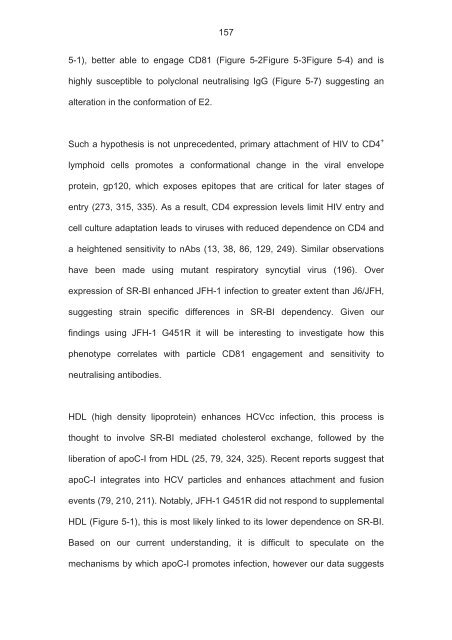The role of scavenger receptor BI in hepatitis - eTheses Repository ...
The role of scavenger receptor BI in hepatitis - eTheses Repository ...
The role of scavenger receptor BI in hepatitis - eTheses Repository ...
Create successful ePaper yourself
Turn your PDF publications into a flip-book with our unique Google optimized e-Paper software.
157<br />
5-1), better able to engage CD81 (Figure 5-2Figure 5-3Figure 5-4) and is<br />
highly susceptible to polyclonal neutralis<strong>in</strong>g IgG (Figure 5-7) suggest<strong>in</strong>g an<br />
alteration <strong>in</strong> the conformation <strong>of</strong> E2.<br />
Such a hypothesis is not unprecedented, primary attachment <strong>of</strong> HIV to CD4 +<br />
lymphoid cells promotes a conformational change <strong>in</strong> the viral envelope<br />
prote<strong>in</strong>, gp120, which exposes epitopes that are critical for later stages <strong>of</strong><br />
entry (273, 315, 335). As a result, CD4 expression levels limit HIV entry and<br />
cell culture adaptation leads to viruses with reduced dependence on CD4 and<br />
a heightened sensitivity to nAbs (13, 38, 86, 129, 249). Similar observations<br />
have been made us<strong>in</strong>g mutant respiratory syncytial virus (196). Over<br />
expression <strong>of</strong> SR-<strong>BI</strong> enhanced JFH-1 <strong>in</strong>fection to greater extent than J6/JFH,<br />
suggest<strong>in</strong>g stra<strong>in</strong> specific differences <strong>in</strong> SR-<strong>BI</strong> dependency. Given our<br />
f<strong>in</strong>d<strong>in</strong>gs us<strong>in</strong>g JFH-1 G451R it will be <strong>in</strong>terest<strong>in</strong>g to <strong>in</strong>vestigate how this<br />
phenotype correlates with particle CD81 engagement and sensitivity to<br />
neutralis<strong>in</strong>g antibodies.<br />
HDL (high density lipoprote<strong>in</strong>) enhances HCVcc <strong>in</strong>fection, this process is<br />
thought to <strong>in</strong>volve SR-<strong>BI</strong> mediated cholesterol exchange, followed by the<br />
liberation <strong>of</strong> apoC-I from HDL (25, 79, 324, 325). Recent reports suggest that<br />
apoC-I <strong>in</strong>tegrates <strong>in</strong>to HCV particles and enhances attachment and fusion<br />
events (79, 210, 211). Notably, JFH-1 G451R did not respond to supplemental<br />
HDL (Figure 5-1), this is most likely l<strong>in</strong>ked to its lower dependence on SR-<strong>BI</strong>.<br />
Based on our current understand<strong>in</strong>g, it is difficult to speculate on the<br />
mechanisms by which apoC-I promotes <strong>in</strong>fection, however our data suggests

















